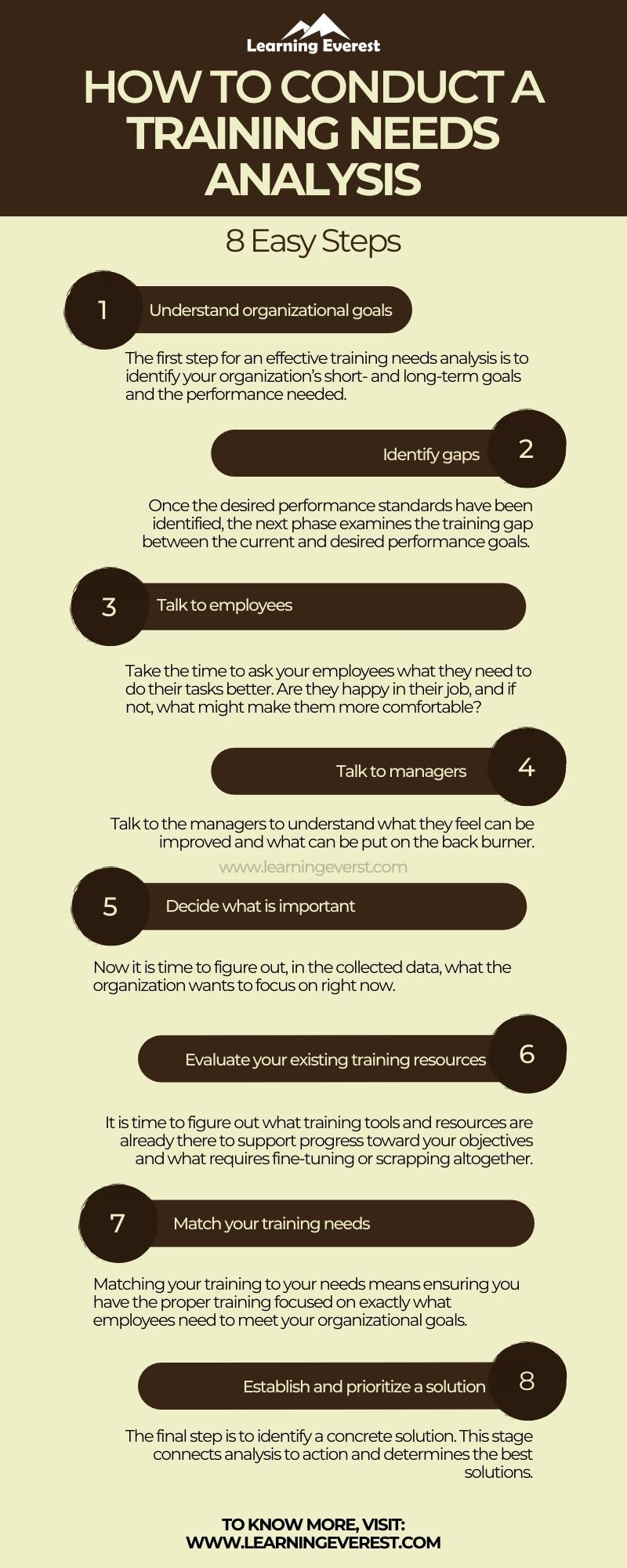Developing new employee training is a significant task, but it is often doomed to fail. It is essential to find out if training will help and, if so, what kind of training is needed. Effective training programs consider questions like, who needs training? Who will do the training? What form will the training take? How will knowledge be transferred to the job? How will the training be evaluated? Training needs analysis includes employee and organizational performance issues to determine if training can help. It involves monitoring current performance using observation, interviews, and questionnaires, anticipating future failures, and identifying the type and level of training required.
Table of Contents
Here are 8 effective steps you can take to conduct a Training Needs Analysis:
1. Understand short and long-term organizational goals
The first step for an effective training needs analysis is identifying your organization’s short- and long-term goals and the performance needed. This helps you to focus on the scope of the training program. The objective is to focus on what your organization wants to achieve. This phase forces organizations to dig deep and assess their business objectives. Your goals can be very concrete (e.g., migrating the entire business to a new system) or somewhat intangible (e.g., improving customer service), but if you think of it as a goal, you can train it and calculate your progress.
2. Examine the performance outcomes and identify gaps
Once the desired performance standards have been identified, the next phase examines the training gap between the current and desired performance goals. This is usually accomplished by reviewing existing performance data and targeted data. Roundtable can help by interviewing leaders and employees and analyzing company metrics. This phase examines the training gaps to determine if and where skill-building can help close the performance gap.
3. Talk to employees
Take the time to ask your employees what they need to do their tasks better. Are they happy in their job, and if not, what might make them more comfortable? Encourage honest feedback by separating these conversations from any HR setting. Allow employees to show what they understand (and identify any gaps) before you start developing your training programs. Make it clear that the organization is interested in setting goals that match employee needs. This can help you find flaws you would have never thought to check.
4. Talk to managers
Managers are the connecting bridge between executives and employees. They have the ability to know how things are going in the boardroom and in the warehouse. Therefore, talk to the managers to understand what they feel can be improved and what can be put on the back burner.
5. Decide on the data points that are important to your team members
Now it is time to figure out, in the collected data, what the organization wants to focus on right now. If employees think that lunch is too short but needs to meet their goal of implementing a more efficient invoicing process, focus on something other than lunch for now. Match the inputs you received to the goals you set at the beginning of the evaluation.
6. Evaluate your existing training resources
Once you figure out what your employees know and have also taken the temperature of your managers, it is time to figure out what training tools and resources are already there to support progress toward your objectives and what requires fine-tuning or scrapping altogether. If you have only ever conducted employee training in a few marathon sessions in a conference room, you may want to use something other than the old resources. These days, Just-in-time training meets employees exactly where they are with technology that makes training efficient and cost-effective. The training needs analysis can also uncover how employees prefer to learn, which can decrease the training friction once you do roll the training out.
7. Match your training to your needs
Matching your training to your needs means ensuring you have the proper training focused on exactly what employees need to meet your organizational goals. Because employees only have a little time for training and development programs, you want to ensure they receive what they need when needed. Focus on providing employees with the required training without a bunch of unnecessary training that is distracting or time-consuming.
8. Establish and prioritize a solution
After you have identified the cause of the performance gap, the final step is to identify a concrete solution. This stage connects analysis to action and determines the best solutions. The result is a Training Needs Analysis report recommending a specific course of action. The goal is first to target the training efforts and skills that will make the most significant difference and then identify the most effective training type.
Now that we have discussed how to conduct a training needs analysis effectively, we hope it will help your organization’s training journey. We will love to hear your comments below if you have any questions or suggestions on effectively conducting a training needs analysis!
Infographic

How to Conduct a Training Needs Analysis
Knowledge Check!
Frequently Asked Questions (FAQs)
What does TNA mean?
TNA stands for Training Needs Analysis.
Why is TNA important?
Training needs analysis plays a crucial role in defining and prioritizing the greatest areas of need in the workplace. It does this by identifying performance and skill gaps, highlighting the importance of your work in addressing these gaps.
How is a TNA used?
Training needs analysis (TNA) recognizes the knowledge gaps for training. By conducting a training needs analysis, organizations find it easy to target the training that needs to be done at this point and which training can be left for later.





